Pro's: Exoticism personified, beautiful people, stunning landscapes, Arabian Nights kind of cities.
Con's: One huge 24/7 hasslorama, the food is good but somewhat monotonous.
In a nutshell: Overwhelming, diverse, sightseeing-rich country, well worth visiting if you know how to ward off those pesky salesmen.
 This is the map of our September 2006 Grand Tour of Morocco's imperial cities, free ports, mountains, deserts and the seaside. The itinerary Casablanca - Rabat - Tangier - Fès - Marrakesh - Aït Benhaddou - Ouarzazate - The Dades Gorges - The Draa Valley - Marrakesh - Essaouira - Casablanca was this time covered by a combination of airplane, train, bus and rented car.
This is the map of our September 2006 Grand Tour of Morocco's imperial cities, free ports, mountains, deserts and the seaside. The itinerary Casablanca - Rabat - Tangier - Fès - Marrakesh - Aït Benhaddou - Ouarzazate - The Dades Gorges - The Draa Valley - Marrakesh - Essaouira - Casablanca was this time covered by a combination of airplane, train, bus and rented car.A step away from the swank Art Nouveau boulevards packed with latest import cars there are sun-scorched comely men in jellabas and pointed-nose slippers pensively drinking fragrant mint tea in fountain-cooled tiled patios while storks watch them perched in their nests on top of half-crumbled minarets. It's exactly the kind of Orient you thought only existed in 19th century travel books. Dive into the baffling maze of a medina, breathe in the ubiquitous gentle whiff of spices, mix in with the colourful jostling crowds in the souks and it's so easy to imagine yourself in a Hauff's fairytale.
Morocco is abuzz with great home-grown music. Local styles - rai and chaabi - married with modern beats produce some really catchy tunes that unfortunately do not make it outside the Maghrebi world. Moroccan Arabic sounds beautiful sung.
- Casablanca
 Fast sprawling metropolises like Casablanca can be found in any modern developing country. The signs of uncontrolled growth are everywhere: high-rise office towers and shanty communities, traffic jams and fancy night clubs. Chic an squalor rub shoulders here in a heady mix of rush for success and desperate resolve. Morocco's New York, its tempo of life is fast-paced, keep up or give up.
Fast sprawling metropolises like Casablanca can be found in any modern developing country. The signs of uncontrolled growth are everywhere: high-rise office towers and shanty communities, traffic jams and fancy night clubs. Chic an squalor rub shoulders here in a heady mix of rush for success and desperate resolve. Morocco's New York, its tempo of life is fast-paced, keep up or give up.Casablanca is a convenient arrival point rather than a tourist destination in its own right but it does have its charm: stylish government buildings dating from the Protectorate era, the Sqala fortress, French Art Nouveau and Art Deco architecture on Boulevard Mohammed V, the frenetic markets of the Old Medina. The second largest religious building in the world, the Mosque of Hassan II sending laser beams towards Mecca is the only one in Morocco which non-Muslims can visit.
First it shocks you, then you get used to the sight, but you still want an explanation: the peculiar Moroccan custom of banging your weenie against the wall, fence, or a tree after peeing. Is it a hygienic measure or a sort of territorial assertion? We did not summon enough guts to enquire...
- Rabat
 Verdant and nicely laid out, the capital of Morocco is a very pleasant city. In the unmistakeably French ville nouvelle, Moorish Art Nouveau official buildings are lined on wide boulevards graced with fountains and rows of palm trees. The dazzlingly white Cathédrale Saint-Pierre is a beautiful specimen of French entre-les-guerres architecture.
Verdant and nicely laid out, the capital of Morocco is a very pleasant city. In the unmistakeably French ville nouvelle, Moorish Art Nouveau official buildings are lined on wide boulevards graced with fountains and rows of palm trees. The dazzlingly white Cathédrale Saint-Pierre is a beautiful specimen of French entre-les-guerres architecture.The abandoned Chellah fortress on the outskirts of the city dates back from the 14th century and has a sadly nostalgic air about it, straight from a Hauff's fairytale. Even from the ruins, that have never known any restoration, you can appreciate the scale and sophistication of what used to be the Sultan's palace. The site claimed to be founded by Carthaginians, contains such unlikely neighbours as the ruins of a Roman city, a Sultan's mausoleum and derelict tombs of Muslim saints. Stork nests perched on top of forlorn minarets overlook a lovely flower garden - the only signs of life in this once mighty stronghold. A true necropolis - city of the dead - it is a poignant reminder of the transience of human ambitions and aspirations.
Safe, clean, efficient and inexpensive railway system is one of the good things Morocco inherited from the French Protectorate era. There are a plenty of excellent photo ops as the train unhurriedly chugs along but these days may be numbered as plans for a high speed train link have been revealed.
- Tangier
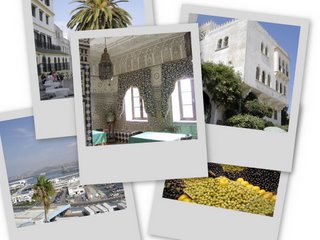 Its rough reputation a thing of the past, Tangier is quite a pleasant place very reminiscent of Southern Spain. Just avoid the ferry port area with its notorious touts and arrive at Tangier's squeaky clean train station. There is an air of certain nostalgia lingering in this city full of vestiges of the bygone times when, under international administration, it became a melting pot of nations, a hotbed of international espionage and a meeting place for world celebrities.
Its rough reputation a thing of the past, Tangier is quite a pleasant place very reminiscent of Southern Spain. Just avoid the ferry port area with its notorious touts and arrive at Tangier's squeaky clean train station. There is an air of certain nostalgia lingering in this city full of vestiges of the bygone times when, under international administration, it became a melting pot of nations, a hotbed of international espionage and a meeting place for world celebrities.These days the once infamous Petit Socco is only alive with afternoon coffee sippers and the floridly ornamental Hotel Continental once patronized by the mighty and famous is now more full of charm than guests.
The tombs of Phoenician seamen who established a port here in the 8th century BC can be found on the sandy beach next to the medieval kasbah. Half-worn letters engraved on the ancient tombstones are remarkably similar and, in fact, directly related to Morocco's native Berber alphabet. On top of the hill, the graceful white-washed Palais du Mendoub boasts a charmingly unkempt Andalusian garden and mosaic fountains. From there one can enjoy sweeping vistas of the busy haven and the hazy shores of Spain.Palm tree lined Avenue d'Espagne, running along the seashore, is where local residents go for paseo, a customary evening stroll, or a cup of flavourful mint tea in one of the many cafés. A powerful mix of fresh mint and green tea, it goes perfectly well with traditional Moroccan sweets, of which there are tens of sorts, all richly sweet and delicious. Pungent and colourful fresh markets in the ever busy medina hide underground from the heat and overflow with tantalising produce.
One thing I learnt in Morocco is to be generous. There is no social security like in Western Europe, the powers that be do not care and people work hard long hours to support their families, so a few dirhams you give a craftsman or a professional story-teller for taking a picture of him can make a difference for that day. Just don't go ego-tripping and feel rich and mighty! Your humility is the purpose of this exercise.
- Fès
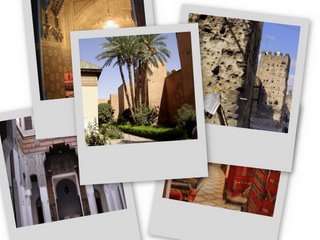 For the truly medieval, mysterious, Harun al-Rachid kind of experience go to Fès. Brace yourself for a shock, because if you thought that "claustrophobic maze of streets" was a just figure of speech, you were very wrong. It will be definitely like nothing you have ever seen before. Any sense of direction will be baffled in the endless labyrinth of crowded narrow lanes splitting at impossible angles into myriads more, ending up in most unexpected places. No map or friendly stranger will be of help, just pray for your luck and keep going until you reach your destination, if ever at all.
For the truly medieval, mysterious, Harun al-Rachid kind of experience go to Fès. Brace yourself for a shock, because if you thought that "claustrophobic maze of streets" was a just figure of speech, you were very wrong. It will be definitely like nothing you have ever seen before. Any sense of direction will be baffled in the endless labyrinth of crowded narrow lanes splitting at impossible angles into myriads more, ending up in most unexpected places. No map or friendly stranger will be of help, just pray for your luck and keep going until you reach your destination, if ever at all.Houses in Fès are fascinating the way all the design and architectural style is present only on the inside - and it is very often truly stunning - while on the outside you will see but faceless mud-coloured walls. Only the richly decorated doors may betray what wonders are hidden behind them.
World's oldest university in continuous operation, the Al-Qarawiyyin, was founded here in 859. While Europe was still suffering through the Dark Ages, Arab scholars were receiving scientific degrees and upholding Classical learning tradition in Fès.
Moroccans are easily one of the best-looking peoples I have ever encountered. Genetically close to Iberians, they come predominantly from the ancient Berber stock, hence the ubiquitous green, grey and even blue eyes. Genetic studies confirm that Arabization was mostly cultural so, technically, it is not even completely correct to call Moroccans Arabs. Whether lighter tinted or with Black African traits as in the South, they are a gorgeous looking nation. As you walk in the streets, you are confronted with scores upon scores of stunning men and women, a true feast for the eye.
- Marrakesh
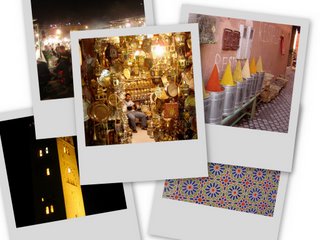 Once known as Morocco City, Marrakesh is the heart of the country. Its bustling souks (markets), country's largest, and the night extravaganza of the Jamaa el-Fna Square are quite a heady experience. All quintessential Moroccan delights are to be found here: exciting aromas, exquisite handicrafts, traditional street performers, the art of bargaining, sultry hammams and tranquil riads. It is the kind of experience you have to pause for, take a break, kick back and let the vibe envelop you.
Once known as Morocco City, Marrakesh is the heart of the country. Its bustling souks (markets), country's largest, and the night extravaganza of the Jamaa el-Fna Square are quite a heady experience. All quintessential Moroccan delights are to be found here: exciting aromas, exquisite handicrafts, traditional street performers, the art of bargaining, sultry hammams and tranquil riads. It is the kind of experience you have to pause for, take a break, kick back and let the vibe envelop you.Outside the traditional quarters, go to be amazed with the modern architecture of Marrakesh. It is always a tasteful mix of the old and modern: Whether a faithful copy of the typical Maghrebi style or a Moorish-inspired Neo-Classical, Moroccan Art Deco or functionalist structure. Local architectural and decorative traditions easily blends with modern building techniques and aesthetics but a lot of credit should be given to the artistic sense of beauty and measure and a mindful adherence to native heritage.
- Tizi'n'Tichka, Ouarzazate and Aït Benhaddou
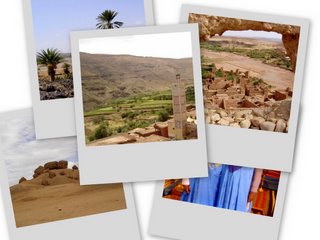 Adobe-brick fortified towns, lush palmeries, multicoloured canyons, whimsically shaped boulders, oases in arid mountain valleys - that is the Ouarzazate region for you. Founded by the French Foreign Legion in 1926, the city is entirely built in the local mud fortress architectural style, of which the French-managed Ibis Moussafir Hotel is a good example.
Adobe-brick fortified towns, lush palmeries, multicoloured canyons, whimsically shaped boulders, oases in arid mountain valleys - that is the Ouarzazate region for you. Founded by the French Foreign Legion in 1926, the city is entirely built in the local mud fortress architectural style, of which the French-managed Ibis Moussafir Hotel is a good example.The road from Marrakesh to Ouarzazate goes via the perilous Tizi'n'Tichka crossing lying at the altitude of 2,300 metres. It consists of hundreds of hairpin turns, none of them with any trace of railing. It can be very treacherous at night, what we discovered when we nearly fell off a precipice in a torrential rain that was washing off huge boulders onto the road surface. That may have been the closest brush with death I have ever had.
The fortified city of Aït Benhaddou lies not far away from Ouarzazate. Its spectacular appearance attracted generations of film-makers as it served as a location for, among others, Lawrence of Arabia, The Last Temptation of Christ and Gladiator.
- The Dadès Gorges
 'Totally worth the long and arduous trip' - that was our resume about the Dadès Gorges -- a photogenic crack in the Atlas Mountains with a rapid stream and ochre-coloured villages at the bottom. Breathtaking views all along the ride will be your reward for navigating the never-ending serpentine. Barren ochre landscape is interspersed with green oases where date palms and even what looks like birch groves thrive on underground water.
'Totally worth the long and arduous trip' - that was our resume about the Dadès Gorges -- a photogenic crack in the Atlas Mountains with a rapid stream and ochre-coloured villages at the bottom. Breathtaking views all along the ride will be your reward for navigating the never-ending serpentine. Barren ochre landscape is interspersed with green oases where date palms and even what looks like birch groves thrive on underground water.As we drove back from the Dadès Gorges, the sun sank down beneath the horizon and soon total darkness engulfed the rocky desert. The only sort of light now were the headlights of our car. When we stopped and turned them off, the world vanished into complete blackness and our stomachs plunged. It was so terrifying, we could not take it for more than a minute, a dip into nothingness our brains were not prepared to take. As we sped away, I cranked up the radio as a reassurance that the populated world is out there and put the spine-chilling experience behind.
- Zillij - Maghrebi mozaic
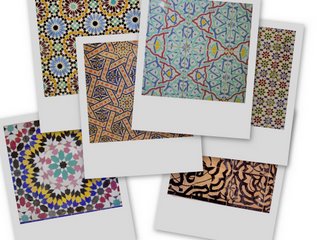 Drawing humans and animals being prohibited by Islam, artists had to resort to developing highly intricate and - to the knowing eye - meaning-loaded geometrical and plant-inspired patterns. Arranging those - apart from the labour involved - is definitely no easy business.
Drawing humans and animals being prohibited by Islam, artists had to resort to developing highly intricate and - to the knowing eye - meaning-loaded geometrical and plant-inspired patterns. Arranging those - apart from the labour involved - is definitely no easy business.Real zillij is made by hand - coloured tiles are broken into even pieces and then are painstakingly arranged in beautiful patterns. This bone-breaking job is by far underappreciated and underpaid and, unfortunately, the craft is slowly dying out.
- Moroccan countryside
 Ranging from dingy to awesome - the Moroccan countryside is an experience for a seasoned adventurer. If you manage to laugh off the inevitable annoyances, your reward as a traveller will be manifold. Scorched and parched during the dry spells it springs to life in lush ochre, red and green after a rain - you understand then why Moroccans love their land.
Ranging from dingy to awesome - the Moroccan countryside is an experience for a seasoned adventurer. If you manage to laugh off the inevitable annoyances, your reward as a traveller will be manifold. Scorched and parched during the dry spells it springs to life in lush ochre, red and green after a rain - you understand then why Moroccans love their land.++++++++++++++++++++++++++++++++++


















